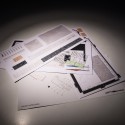







Mies van der Rohe Pavilion "do it yourself" Model
by PAPETI
Material: Cardboard and plastic for the details
Size: 28,5 × 12,5 × 3 cm
Scale: 1:200
Packaging: Cardboard box 35,5 x 20 x 2 cm
The Barcelona Pavilion was designed by Ludwig Mies van der Rohe as the German National Pavilion for the 1929 Barcelona International Exhibition, is regarded as one of the architect's masterpieces and one of the icons of the Modern Movement. It was reconstructed in 1986 under the supervision of Cristian Cirici, Fernando Ramos and Ignasi de Solà-Morales.
The building, a combination of classical and modern, shows the essence of the architecture of Mies van der Rohe in terms not onlyh of composition but also of the technological advances that were taking place at the time.
The Pavilion is characterized by the simplicity of its elements, its geometrical composition and the way it makes a distinction between structure and the external envelope. Perched above the travertine podium are two flat concrete roofs, the larger of which rests on eight cross-shaped steel columns.
Beneath this big roof, the vertical planes are freely distributed. Since the horizontal and vertical planes are endowed with the same degree of importance, we perceive the entire space as a unit, without making any distinction between exterior and interior. The building as a whole denotes both the classical legacy and technological progress, in which travertine, green marble and golden onyx coexists in harmony with the reflections in the large glazed surfaces, the steel, the water and the dormer window (a double wall of white glass with an entry of natural light and artificial lighting), thereby creating different spaces and itineraries.
Wandering through the Pavilion we find the hall with the golden onyx wall, the black carpet and the red velvet curtains, together forming the German flag. Thisis also the place for the Barcelona chairs, designed by the architect himself and Lilly Reich to receive King Alfonsos XIII and Queen Victoria Eugenia.
In the hall patio we discover one of the water surfaces and Georg Kolbe's sculpture The Dawn, a vertical element that acts as a point of visual focus in this closed space and is reflected in a number of different ways.
The building was conceived as a haven of tranquility from which to guide visitors to one of the major attractions of the 1929 International Exhibition, namely the Poble Espanyol (Spanish Village). They passed through the Pavilion, though not directly. The tangential access to the podium and the set of planes we come across once we are at the top guide us along an itinerary that allows us to cross the building through its different spaces.